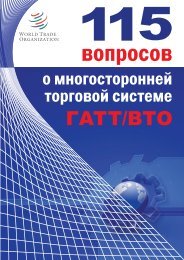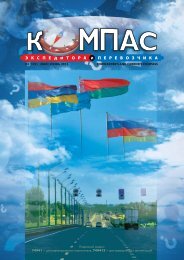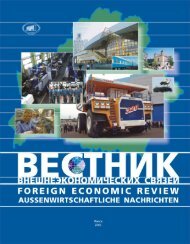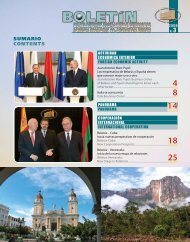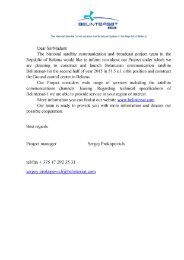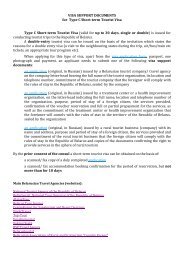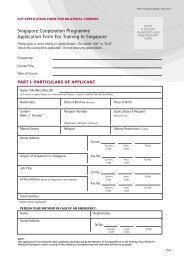facilitates reserve investments and regionalcoordination of monetary policies. Its potentialis limited by its incomplete regionalmembership; Brazil, the region’s largest economy,does not participate. 33• The Andean <strong>Development</strong> Corporation isgaining attention due to its fourfold growthin lending over 1991–2007 and almostexclusive ownership by members, nearly allof which are developing countries (exceptPortugal and Spain). 34Such regional arrangements, however, do notnecessarily reduce the role of the IMF. Largedisbursements from the funds can require borrowingcountries to be under IMF surveillanceprogrammes, as with the Chiang Mai InitiativeMultilateralization (box 5.3).The evolving regional financial architecturefostered by countries of the South offers renewedspace for policies that emphasize pragmatismrather than ideology and ensures thatconditionality is narrow and appropriate tothe country (box 5.4). 35 Regional institutionsthat lend closer to home are also more likelyto design programmes that are more sensitiveto political concerns and economically appropriate,with light-touch surveillance and lessemphasis on conditionality.Some institutions, such as the nascent Bankof the South, 36 renounce conditionality altogether.Others, including the Chiang MaiInitiative Multilateralization and the ArabMonetary Fund, use conditionality only inspecific circumstances, and it remains a point ofdiscussion among members. Still others, such asthe Latin American Reserve Fund, apply surveillancebut do not use the IMF’s top-downapproach and instead collaborate with borrowinggovernments.Regional trade agreementsRegional and subregional trade arrangementshave expanded and deepened in Africa, Asiaand Latin America, even as the Doha roundof global trade negotiations has stalled.Agreements that open up South–South tradehold enormous potential, with benefits atleast as large as those providing greater accessto markets in the North. OECD estimatesBOX 5.3Regional finance in Asia: Chiang Mai Initiative Multilateralization and the Asian <strong>Development</strong> BankThe current financial crisis has been a powerful impetus for expandingthe scope of the Chiang Mai Initiative, a regional agreement among theAssociation of Southeast Asian Nations, plus China, Japan and the Republicof Korea (ASEAN+3). In early 2009, the initiative was multilateralized andrenamed the Chiang Mai Initiative Multilateralization. At that time, disbursementsof more than 20% of the credits available to a country requiredthat the borrowing country be under an International Monetary Fund (IMF)surveillance programme to address the difficult task of devising and implementingregional surveillance.ASEAN+3 members have continued to deepen the Chiang Mai InitiativeMultilateralization. In May 2012, the size of the currency swap pool was doubledto $240 billion. For 2012–<strong>2013</strong>, the need to be under an IMF programmedoes not become operative until the swap drawn equals 30% of the maximumfor the country (40% in 2014, pending the outcome of current discussions). Thematurity of both the IMF-linked and the delinked swaps were lengthened. Andfor the first time, a precautionary credit line facility was introduced, allowingmembers to draw on swaps governed by a formula based on country size. (TheAsian Bond Market Initiative was also expanded in May 2012.)The ASEAN+3 Macroeconomic Research Office opened on 30 January2012 to conduct IMF Article IV–type monitoring of members. It describesitself as the “regional surveillance unit of the Chiang Mai InitiativeMultilateralization”. Its purposes are to monitor and analyse regional economiesand to contribute to the early detection of risks, implementation ofremedial actions and effective decisionmaking by the initiative. Some observershave noted the tensions over the mandate and the continuing reluctancein Asia to criticize the policies of regional neighbours and thus theobstacles to conducting firm surveillance.Prior to the global financial crisis, the Asian <strong>Development</strong> Bank (ADB)was already lending more in the region than the World Bank was. The crisisaccelerated this trend. In some cases, the ADB responded more quicklyand with larger loans than the IMF and the World Bank did, and it introducednew types of temporary rapid financing programmes and countercyclicallending facilities to support developing and low-income countries. InApril 2009, Indonesia proposed that a portion of the IMF’s new financingbe devolved to the ADB. With Group of 20 backing, the ADB introduced theCountercyclical Support Facility to provide up to $3 billion to economies inAsia affected by the crisis.Between 2008 and 2009, the ADB’s lending commitments grew 42%and its disbursements 33%. Other regional development banks quickly followedthe ADB’s example and were granted a portion of the new funds committedto the IMF to establish new regional lending facilities to promoterapid counter cyclical support within their region.Source: Woods 2010; Chin 2010, 2012; Ocampo and others 2010; ADB 2009; Ciorciari 2011; AMRO 2012.114 | HUMAN DEVELOPMENT REPORT <strong>2013</strong>
a welfare gain for the South of $59 billion ifSouth–South tariffs were lowered to that ofNorth–South levels. 37 Even within Africa,given appropriate institutional arrangementsfor more open agricultural trade, there is hugepotential for increasing the trade of the region’smany and diverse crops.An example of a successful regional arrangementis the Sao Paulo Round in 2010, in which22 developing countries agreed to reduce tariffsat least 20% on about 70% of the trade amongthemselves. The reductions were negotiatedwithin the 1989 framework of the GlobalSystem of Trade Preferences, established to takeadvantage of the enabling clause within theagreements of the WTO, which allows developingcountries to provide concessions to eachother without jeopardizing their most favourednation obligations.Bilateral arrangements can facilitate tradeflows when multilateral negotiations stall.Other options such as preferential trade arrangementsfor furthering the goal of freer,nondiscriminatory trade could be overseen by aglobal multilateral institution like the WTO orby regional bodies.Take, for example, negotiations aimed at reducingthe massive production and export subsidiesin agriculture given mainly by developedcountries. Those subsidies distort world tradeand expose farmers in developing countries tounfair competition. However, this issue is almostimpossible to settle satisfactorily in a bilateralor regional setting; it requires multilateralBOX 5.4Enrique Garcia, President, CAFCAF: a Latin American development bankWhen established in 1970, the multilateral bank CAF had five Andean countrymembers (Bolivia, Colombia, Ecuador, Peru and Venezuela). Today, itsshareholders include 18 countries from Latin America, the Caribbean andEurope as well as 14 private banks, and it obtains most of its funding inglobal financial markets. CAF promotes sustainable development and regionalintegration through credit operations, grants and technical supportand offers financial structuring to public and private sector projects in LatinAmerica. Its headquarters are in Caracas, and it has offices in Asuncion,Bogota, Brasilia, Buenos Aires, La Paz, Lima, Madrid, Montevideo, Quitoand Panama City. Over the last decade, Latin America has experienced rapideconomic growth thanks to a favourable external environment, which hasresulted in higher commodity prices, a stable macroeconomic environmentand greater domestic demand due to poverty reduction and higher income.CAF has helped its member countries take advantage of these favourableeconomic conditions through a comprehensive development agenda that includesprojects and programmes designed to support the region’s productivetransformation and its competitive participation in the global economy, toimprove the quality of institutions and to promote environmental conservation.CAF has provided substantial financing at times when markets were“dry” and other international financial institutions were imposing stringentconditions on their financing.Among the reasons for CAF’s success in the region are its Latin Americanessence, the strong political and financial commitment of its member countries,the maintenance of prudent financial policies (especially in times ofeconomic stress) and its policy of nonconditionality. Today, CAF is one ofthe main sources of multilateral financing for infrastructure and energy inthe region, with approvals of more than $10 billion at the end of 2011, orsome 30% of total multilateral lending for Latin America (compared withand $12.4 billion for the Inter-American <strong>Development</strong> Bank and $13.9 billionfor the World Bank; see Ocampo and Titelman 2012). CAF’s countercyclicalrole in times of economic turbulence in international markets and itssupport to shareholders when financing has become scarce have been especiallyvaluable. In addition to channelling funds from international marketsto the region, directed mainly to infrastructure projects, CAF, together withits member countries, has designed and implemented an ambitious agendaof programmes and projects supported by grants aimed at tackling some ofLatin America’s major obstacles to growth.CAF borrows in international capital markets through a funding strategythat aims to diversify sources of financing to mitigate interest rate and currencyrisks while matching the average maturity of its assets and liabilitiesto maintain sufficient liquidity in its portfolio. CAF obtained its first creditratings in 1993 from the three main rating agencies, and its ratings havesteadily improved, even during economic crises in the region. CAF is nowthe highest rated frequent bond issuer in Latin America. Since 1993 CAFhas borrowed more than $13.9 billion through 87 bond issues in the mostimportant international capital markets in the Asia, Europe Latin Americaand the United States. Prudent financial policies have made CAF a profitableinstitution that reinvests, through grants and technical cooperation, inprogrammes and projects to support its member countries.CAF’s performance has been distinguished due to capacity to adaptto a changing and challenging environment. Of particular importance hasbeen its governance structure. Since its foundation, CAF’s shareholders havegiven the institution the autonomy to design and implement operational policieswithout political pressure. Member countries have always supportedthe institution. Never in CAF’s history has a member country defaulted on itsobligation, even during economic crises. With an ownership that is almostentirely Latin American (Portugal and Spain are minority shareholders dueto their historical ties to the region), CAF has avoided the conflicts that havearisen in other multilateral institutions where donors’ and recipients’ aimsare not always aligned. In this regard, CAF is recognized as an institution runby and for Latin America, providing a useful example of pragmatic financialintegration.Chapter 5 Governance and partnerships for a new era | 115
- Page 1 and 2:
WNSEHuman DevelopmentReport 2013The
- Page 3 and 4:
Human Development Report 2013The Ri
- Page 5 and 6:
Human Development Report 2013 TeamD
- Page 7 and 8:
Finally, the Report also calls for
- Page 9 and 10:
Heather Simpson, Ben Slay, Mounir T
- Page 11 and 12:
3.6 India’s Supreme Court issues
- Page 13 and 14:
OverviewOne of the most heartening
- Page 15 and 16:
and sustainability are fully incorp
- Page 17 and 18:
Without investment in people, retur
- Page 19 and 20:
opportunity to reap the full benefi
- Page 21 and 22:
Woods institutions, the United Nati
- Page 23 and 24:
IntroductionWhen developed economie
- Page 25 and 26:
leading economies—Brazil, China a
- Page 27 and 28:
comparable access to information, e
- Page 29 and 30:
mobile phones: cellular banking is
- Page 32 and 33:
“The political problem ofmankind
- Page 34 and 35:
BOX 1.1Fairness, macroeconomics and
- Page 36 and 37:
BOX 1.3Amartya Sen, Nobel Laureate
- Page 38 and 39:
FIGURE 1.1Income per capita is risi
- Page 40 and 41:
BOX 1.4Subjective indicators of wel
- Page 42 and 43:
FIGURE 1.4There is notable variatio
- Page 44 and 45:
FIGURE 1.6Most regions show declini
- Page 46 and 47:
Progress in humandevelopment achiev
- Page 48 and 49:
BOX 1.7Social competencies: human d
- Page 50 and 51:
TABLE 1.3Inequality and satisfactio
- Page 52 and 53:
Not all countries havethe precondit
- Page 54 and 55:
“When the music changes,so does t
- Page 56 and 57:
BOX 2.1The South’s integration wi
- Page 58 and 59:
FIGURE 2.1As a share of world merch
- Page 60 and 61:
BOX 2.2Acquisitions by the South of
- Page 62 and 63:
FIGURE 2.3Between 2000 and 2010, In
- Page 64 and 65:
FIGURE 2.4Export earnings per capit
- Page 66 and 67:
BOX 2.6Final assembly is about more
- Page 68 and 69:
Instead of having a centreof indust
- Page 70 and 71:
FIGURE 2.6Emerging market economies
- Page 72 and 73:
Developing countriestrade more amon
- Page 74 and 75:
“We cannot expect thatall nations
- Page 76 and 77: TABLE 3.1Selected developing countr
- Page 78 and 79: A common featureof countries thatha
- Page 80 and 81: More important thangetting prices r
- Page 82 and 83: BOX 3.5Eastern Europe and Central A
- Page 84 and 85: States have to beconscious that the
- Page 86 and 87: As countries develop,they tend to d
- Page 88 and 89: Having weathered theAsian financial
- Page 90 and 91: Providing publicservices that contr
- Page 92 and 93: Advancing health requiresmore than
- Page 94 and 95: Universal public healthand educatio
- Page 96 and 97: • China. The Minimum Livelihood G
- Page 98 and 99: “Each generation will reap whatth
- Page 100 and 101: concerns will make for a complex en
- Page 102 and 103: A greater emphasison education cans
- Page 104 and 105: FIGURE 4.1Under the fast track scen
- Page 106 and 107: Around the worldpeople are calling
- Page 108 and 109: FIGURE 4.4Different environmental s
- Page 110 and 111: FIGURE 4.5Education policies can al
- Page 112 and 113: BOX 4.2China and Ghana: who benefit
- Page 114 and 115: FIGURE 4.8countries thus converge t
- Page 116 and 117: “Let us join hands to try tocreat
- Page 118 and 119: Areas of globalinternational concer
- Page 120 and 121: Addressing climatechange requires t
- Page 122 and 123: International governanceis increasi
- Page 124 and 125: BOX 5.2Jo Leinen, Member of the Eur
- Page 128 and 129: Responsible sovereigntytakes the lo
- Page 130 and 131: FIGURE 5.1Under the accelerated pro
- Page 132 and 133: Good policymakingrequires greater f
- Page 134 and 135: A fair and less unequalworld requir
- Page 137 and 138: NotesOverview1 Atsmon and others 20
- Page 139 and 140: 25 Blinder 2006.26 UNIDO 2009.27 UN
- Page 141 and 142: which is 61.7 deaths per 1,000 live
- Page 143 and 144: ReferencesAbdurazakov, A., A. Minsa
- Page 145 and 146: urban_world_cities_and_the_rise_of_
- Page 147 and 148: Kamau, P., D. McCormick, and N. Pin
- Page 149 and 150: Labor Administration. Geneva: Inter
- Page 151 and 152: Human Development Report 2013The Ri
- Page 153 and 154: Statistical acknowledgementsThe Rep
- Page 155 and 156: Key to HDI countries and ranks, 201
- Page 157 and 158: Human Development Report 2013The Ri
- Page 159 and 160: Human Development Report 2013The Ri
- Page 161 and 162: Human Development Report 2013The Ri
- Page 163 and 164: Human Development Report 2013The Ri
- Page 165 and 166: Human Development Report 2013The Ri
- Page 167 and 168: Human Development Report 2013The Ri
- Page 169 and 170: Human Development Report 2013The Ri
- Page 171 and 172: Human Development Report 2013The Ri
- Page 173 and 174: Human Development Report 2013The Ri
- Page 175 and 176: Human Development Report 2013The Ri
- Page 177 and 178:
Human Development Report 2013The Ri
- Page 179 and 180:
Human Development Report 2013The Ri
- Page 181 and 182:
Human Development Report 2013The Ri
- Page 183 and 184:
Human Development Report 2013The Ri
- Page 185 and 186:
Human Development Report 2013The Ri
- Page 187 and 188:
Human Development Report 2013The Ri
- Page 189 and 190:
Human Development Report 2013The Ri
- Page 191 and 192:
Human Development Report 2013The Ri
- Page 193 and 194:
Human Development Report 2013The Ri
- Page 195 and 196:
Human Development Report 2013The Ri
- Page 197 and 198:
Human Development Report 2013The Ri
- Page 199 and 200:
Human Development Report 2013The Ri
- Page 201 and 202:
Human Development Report 2013The Ri
- Page 203 and 204:
Human Development Report 2013The Ri
- Page 205 and 206:
Human Development Report 2013The Ri
- Page 207 and 208:
Human Development Report 2013The Ri
- Page 209 and 210:
Human Development Report 2013The Ri
- Page 211 and 212:
Statistical referencesADB (Asian De
- Page 213 and 214:
Core features of the model pertinen
- Page 215 and 216:
Countries and HDI ranks in 2012 and




